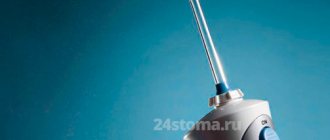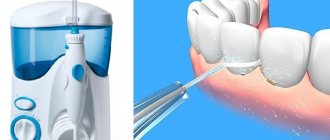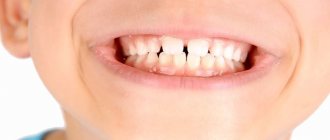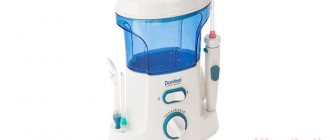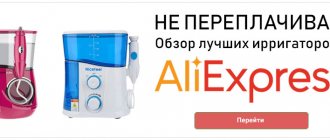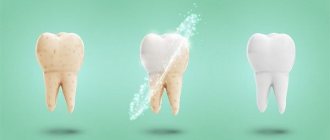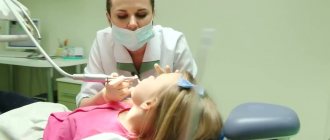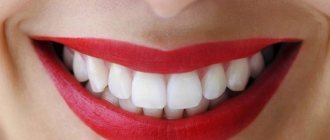Publication date: 11/18/2021
A regular or electric toothbrush, toothpaste, floss - a list of hygiene products and items that everyone uses when brushing their teeth. However, to improve these indicators, especially for patients undergoing orthodontic treatment (with braces), in the presence of crowns and dentures, veneers and implants, irrigators are recommended. Why do you need an oral irrigator and how to choose one? The dentists of the Axioma Dental clinic will help you with this issue.
Why do you need an irrigator?
- For the prevention of caries. The irrigator helps get rid of plaque on the teeth and tongue. It also cleans hard-to-reach areas such as molars, wisdom teeth, interdental spaces and orthodontic appliances.
- For the prevention and treatment of gum diseases. The irrigator improves blood circulation and accelerates regeneration processes. This helps strengthen the gums and reduce bleeding.
- For the care of implants, crowns, bridges, braces and other structures. The irrigator washes them and the cavities underneath them.
- To eliminate the cause of bad breath - bacterial plaque.
- For the prevention of gingivitis. The disease can occur in pregnant and lactating women due to deterioration of blood supply to the mucous membranes.
There are no contraindications to using the irrigator.
Types of irrigators
Irrigators are stationary and portable. For home use, it is better to choose a stationary one - it is more reliable and will last longer. Some of these devices can be mounted on the wall. This is useful if you have limited sink space.
If there is no outlet in the bathroom, you can choose a portable irrigator - it runs on a battery and can be charged anywhere. A portable irrigator is lighter and smaller than a stationary one, and is convenient to take on trips.
The first important parameter for choosing an irrigator is the power of the water jet.
.
A portable irrigator must have a power of at least 520 kilopascals (kPa), and a stationary one must have a power of at least 550 kPa. The second selection parameter is the number of jet pulsations
per minute. The optimal value is 1200 pulsations.
Irrigators also differ in their mode switching
. For stationary ones, mode switching occurs smoothly, for portable ones - stepwise. If the waterpik is used by children or people with gum disease, it will be more difficult for them to adjust the comfortable power on a portable one.
Comparison of popular models
To help you make the right choice, we have prepared comparison tables of stationary and portable irrigators. All important characteristics of the devices are listed here.
Stationary irrigators
| Waterpik WP-100 E2 Ultra | Revyline RL 100 | Waterpik WP-660 Aquarius | Revyline RL 500 | Aquajet LD-A8 | B.Well WI-922 | Donfeel OR-820D Compact | Donfeel OR-840 AI | CS Medica AquaPulsar CS-2 | |
| Tank volume, ml | 650 | 600 | 650 | 600 | 500 | 600 | 600 | 600 | 500 |
| Number of nozzles | 7 | 7 | 7 | 7 | 5 | 7 | 8 | 5 | 5 |
| Guarantee | 2 years | 2 years | 2 years | 2 years | 1 year | 2 years | 1 year | 1 year | 2 years |
| Power | from 70 to 690 kPa | from 210 to 870 kPa | from 70 to 690 kPa | from 210 to 870 kPa | from 290 to 810 kPa | from 207 to 827 kPa | from 100 to 650 kPa | 80 - 680 kPa | from 150 kPa to 850 kPa |
| Number of pulsations, min | 1400 | 1200-1700 | 1400 | 1200-1700 | 1200 | 1250-1850 | 1250 — 1550 | 1250 — 1700 | from 1100 to 1600 |
| Wall mount | No | No | No | No | There is | No | No | No | There is |
Portable irrigators
| Waterpik WP-450 | Revyline RL 450 | Philips Sonicare AirFloss Ultra HX8381/01 | Panasonic EW-DJ40 | Panasonic EW1211A | Revyline RL 200XL | B.Well WI-911 | B.Well WI-912 | CS Medica AquaPulsar CS-3 Basic | |
| Tank volume, ml | 210 | 240 | 15 | 165 | 130 | 300 | 150 | 150 | 130 |
| Number of nozzles | 4 | 5 | 1 | 1 | 2 | 2 | 2 | 5 | 2 |
| Guarantee | 2 years | 2 years | 2 years | 2 years | 2 years | 2 years | 1 year | 1 year | 2 years |
| Power | from 310 to 520 kPa | from 130 to 760 kPa | 390 and 590 kPa | from 200 to 590 kPa | from 210 to 700 kPa | 275 - 620 kPa | 378 - 720 kPa | up to 590 kPa | |
| Number of pulsations, min | 1450 | until 1700 | 1400 | 1400 | 1400-1800 | 1600 | 1420 | 1200 — 2000 |
Nozzles and their types
The irrigator comes with one or more attachments. Remember that each family member should have their own nozzle. Nozzles can be purchased and changed. They come in several types.
- The standard
brush head is suitable for cleaning healthy teeth and gums. - An orthodontic
attachment is needed to remove plaque under braces and under the gingival margin. For these purposes, you can use a standard attachment, but the orthodontic one is more convenient. - A periodontal
nozzle with a thin soft rubber tip directs the jet beyond the gingival margin and into the periodontal pockets. It should not be used at maximum power - otherwise it may suddenly fly off or tear. - Nozzle for implants
, crowns and bridges - with 3 tufts of bristles for easy cleaning of structures. - The tongue cleaner
removes plaque from the tongue and cheeks, eliminating the cause of the unpleasant odor. - For additional plaque removal there is a brush attachment
. But it does not replace a regular toothbrush. - A nasal nozzle
is needed to irrigate the nasal cavity during the treatment or prevention of rhinitis and sinusitis.
Standard attachments need to be changed approximately every six months, and periodontal, orthodontic and brush attachments - every 3 months. Remember that each family member should have their own nozzle.
Differences from a toothbrush
When comparing the effectiveness of irrigators and regular brushes, there are several key factors to consider.
Degree of purification
The device cleans much deeper, allowing you to remove pieces of food stuck between your teeth, in chips or cracks. The effectiveness of the irrigator can be compared with the simultaneous use of dental floss and an electric brush.
Gentle care
The use of an electric toothbrush is contraindicated with some types of dental plates or braces. The irrigator is able to clean any structures in the oral cavity without damaging them. Thus, an irrigator is the only option for solving the problem of cleaning teeth in case of installed braces.
Freshness
An electric toothbrush certainly has a refreshing effect when used with the right toothbrush. However, using an irrigator allows you to achieve a similar effect with plain water.
In order to make your teeth whiter, it is preferable to use not an irrigator, but a brush along with whitening toothpaste
Balms for irrigator
The use of special balms for the irrigator can enhance the effect of the procedure, as their components have antibacterial and anti-inflammatory properties. The choice of liquid depends on your goals. Some liquids help strengthen enamel, others are effective against inflammatory gum diseases, and others have a complex effect. On our website you can buy liquids for irrigators from the companies Waterdent, Donfeel, Professor Persin, Albadent, Asepta, ROCS and Iriks. It is profitable to buy sets of several bottles.
How to choose a liquid for an irrigator
When choosing a liquid for an irrigator, you should take into account its composition and purpose. You should not pour hard running water into the irrigator - it may contain impurities harmful to the enamel, and it can also lead to damage to the device over time. Depending on the active substances, solutions will help solve different problems. They come in 4 types.
- Strengthening enamel
- with fluoride. - Therapeutic and prophylactic
- with antiseptics and plant extracts. - For fresh breath
- with mint, menthol or eucalyptus. - For the treatment of periodontal disease
- with bioantioxidants and anti-caries additives.
Allergy sufferers are advised to choose hypoallergenic balms.
Irrigator care
Here are a few rules for caring for your irrigator.
- Do not touch the charger with wet hands
. - Do not allow the plugged-in device to come into contact with water
. - Carefully monitor the integrity of the cord
. - Do not wipe the housing with alcohol
. - Do not place the device near heating devices
. - Fill the reservoir only with water and special balms
for the irrigator. - While the irrigator is operating, do not hold the pause button for long
- the motor may burn out. - Use only attachments recommended by the manufacturer
. - If you take the irrigator on the road in winter, there should be no water in it
- otherwise it will freeze and the device will break. To remove all the water, turn on the irrigator. Let it run until all the liquid comes out.
Operating principle
The essence of the principle of operation of the irrigator is quite simple: liquid (water or solution) is poured into a special container of the device, the compressor creates pressure, and when you press the button, a stream escapes from the tip. Getting on the teeth, gums, tongue, palate, it “knocks down” microparticles adhering to the mucous membrane and washes them away. The person can only spit out the waste liquid.
Important: the liquid in the device is supplied under pressure, so people who have any acute inflammation of the mucous membranes of the gums, tongue, cheeks and lips are not recommended to use the irrigator for a hygienic procedure.
Misconceptions
❌ An irrigator can replace a toothbrush
Using a toothbrush is essential for quality oral care. An irrigator is an additional hygiene product; it can replace dental floss, but not a brush with toothpaste.
❌ It is enough to use the irrigator a couple of times a week
The irrigator should be used every time after brushing your teeth, that is, in the morning and in the evening.
❌ You definitely need to use balms for irrigators
You can use an irrigator with regular warm water. It must be filtered or boiled. Irrigator balms help fight some diseases, but their use is not necessary.
❌ You can pour herbal decoctions and regular rinses into the irrigator
Only water and special balms can be poured into the irrigator. Mouthwashes foam heavily in the reservoir, and herbal infusions leave a sediment. All this can quickly break the device.
❌ The fluid supply hose must be long
The hose should not be too long, as you will still have to bend over the sink when using the irrigator. There is no point in using the device while standing.
❌The more power levels the irrigator has, the better it is
Modern irrigators have smooth power adjustment, and the number of divisions on the toggle switch is quite arbitrary.
Medicinal use
Medical irrigators have long been widely used in dentistry for almost all procedures, often without pressure, but with the purpose of supplying water “for spitting.”
For medicinal purposes, a household irrigator can be used:
- with increased plaque formation on the teeth;
- at the initial stage of gingivitis;
- with chronic periodontitis without exacerbation or with mild exacerbation in the initial stage.
For therapeutic purposes, instead of water, antiseptic liquids are used (solution of furatsilin, miramistin, chrolhexidine, special elixirs). The use of herbal decoctions and tinctures is limited by most device manufacturers, due to possible breakdown of the irrigator due to blockage of the passages.
Applications outside dentistry
With the increasing popularity of the device, it turned out that the irrigator is used not only in dentistry. Many people believe that using an irrigator is better to remove bacteria from the surface of the tonsils than with regular rinsing. The use of irrigators for irrigation with medicinal solutions is useful:
- tonsils for chronic tonsillitis;
- the back wall of the throat for pharyngitis (during this procedure, breathing is held for a short inhalation, and the root of the tongue should be pressed tightly, as when gargling).
When reviewing articles and user reviews from the Internet, it also turned out that there are craftsmen who, in case of chronic tonsillitis, used an irrigator with an attachment for periodontal pockets to wash out purulent plugs from the tonsils. Theoretically, with certain skills, this can be done. But it’s better to trust a specialist.
In otolaryngology, the removal of plugs from lacunae is carried out using a special curved needle with a blunt end. It is injected into the lacuna of the tonsils and under pressure with a medicinal solution, the pathological contents are washed out of them. If for this purpose you do not skillfully use a nozzle designed for rinsing gum pockets, you can, instead of rinsing it out with water pressure, on the contrary, drive the plugs deeper.
Important! Do not try to wash out tonsil plugs yourself; there are otolaryngologists for this.
Total: which irrigator is better to choose?
The choice of irrigator depends on your lifestyle, the nature of your dental problems and the number of future users.
Stationary or portable
If you need the device on business trips and trips, choose a portable, travel irrigator. Pay attention to the volume of the tank, the presence of a carrying case and the battery capacity. When choosing a portable irrigator, check whether it has a battery charge indicator. If it is not there, a sudden discharge of the device may be an unpleasant surprise.
If it is possible to install a stationary device at home, choose it, it will last longer. When purchasing, pay attention to the length of the network cable - it should allow you to place the device in a convenient place. The advantages of a stationary irrigator include high power, a spacious tank, and a large selection of nozzles.
Recommendations
- If you need an irrigator for braces
, dentures or crowns, choose an irrigator with a special attachment included. - If you are buying a irrigator for a large family
, choose models with a large tank and the required number of nozzles. - If the irrigator will be used by children or people with gum disease
, the operating mode should be more gentle. The lower the minimum power of the device, the more comfortable they will be. Also in this case, smooth power control is important.
Contraindications for irrigation
Despite the broad indications for irrigation, there are conditions in which its use is undesirable or limited. These include:
- Acute severe periodontitis with suppuration and a high degree of bone tissue melting. The use of irrigators can increase the hematogenous spread of infection and bone destruction.
- Severe bleeding gums. High blood pressure will increase the fragility of blood vessels, and bleeding may turn into hemorrhage.
- You should not use irrigation within 24 hours after tooth extraction and some dental operations (always check such nuances in the dentist’s chair).
The use of an irrigator in young children is limited due to their lack of brush skills. You can use the irrigator from the age of 6, under parental supervision.

